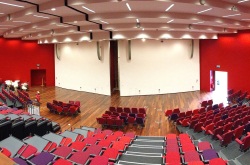
Martin Audio OmniLine arrays were recently installed in the Ivor Crewe Lecture Hall (ICLH) at Essex University, primarily to provide voice amplification in the theater, which is used for high profile graduation ceremonies, conferences and lectures.
However, a further challenge is that the theater can also split into two self-contained 500-seat spaces when the positioning of the loudspeakers would automatically change, since they are hung on the walls that would move during the transformation.
Nigel Meddemmen, Martin Audio sales support, addressed the challenge by carrying out venue predictions as an accurate 2D slice using the OmniLine software. The calculations enabled him to position the arrays to ensure best possible response and generate the required rigging, inter-module angles and equalization.
Other challenges included the use of a variety of microphones in front of the PA system, including tricky omnidirectional lavalier mics, which tend to be favored by university lecturers — plus the insistence on wall-mounting the arrays since the roof structure had not been rated for a flown system.
The biggest problem, however, was the fact that the rear walls of the hall move, splitting the auditorium via a central removable divide when it needs to open up. A total of four OmniLine arrays were specified to cover each of the two sides, yet maintain pattern control across exactly the same area when the room is functioning as a single large space.
However, the front wall in each of the two halves is hinged, and when moved backwards, it would swing the outside arrays inward to leave gaps in the coverage at the sides while producing a troublesome coverage overlap in the center between the two ‘inner’ arrays.
The solution was to fix the vertical coverage of the arrays while leaving a degree of play in the horizontal alignment, which would normally be tightened off once commissioned to prevent any movement. An ‘angle stop’ system was therefore designed to slot behind the standard OmniLine wall mount brackets, to make it easy to accurately reposition the arrays when the room configuration changes.
LMC Audio London provided the 64 OmniLine modules needed for the project, which was overseen by technical sales supervisor Sam Simon-Norris. Scan Audio handled the installation.
“I first saw the product at ISE and spoke with technical staff from Martin Audio about the specific problems we have with the 1,000-seat lecture theater, namely hard surfaces and the fact that the only place to hang speakers was behind the microphones, causing problems with feedback,” states Tessa Rogowski, head of Customer Services –– Information Systems at Essex University. “There was no question in my mind that this needed to be solved once and for all. Martin Audio were the first people who actually appeared to understand my problems, and had the technology to ensure that the installation would be carried out correctly, the first time.”
The installation was carried out over four days, including one day to decommission the existing large custom column loudspeakers and a small line array.
Scan Audio managing director William (Dee) Couchman explains, “The main challenges included fitting the four line arrays of 16 OmniLine modules to the two large moveable projection walls. The tops of the arrays were only a few inches beneath the stage ceiling area so we used specialized hoist equipment to precisely move these into position above the supporting brackets while avoiding damage to the projection surface.
“The setting provided by the design software required only minor adjustment to produce a clear intelligible sound for this mainly speech-based reinforcement system,” he continues. “Music reproduction was surprisingly full range from such a compact line array, which blended very well with the interior of the hall.”
Summarizes Simon-Norris, “Nigel’s solution for overcoming the two-zone problem was as ingenious as it was practical, utilizing an additional bracket to allow the arrays to be swung from one position to another, giving optimum coverage in both modes. This really was a breakthrough for the project, and left us with no doubts that this system would be the perfect choice for the ICLH.”
